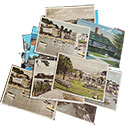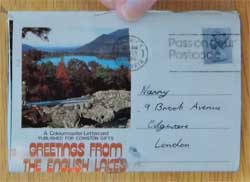Picture letters and picture postcards in the past

Picture letters and picture postcards used to be the accepted way for people to let friends and colleagues know that they were away on holiday - particularly if that was somewhere considered special or even exotic at the time. They were common before and after the Second World War, but went out of fashion to a large extent once photographs could be sent quickly and easily be phone. This page illustrates picture letters, explores the types of picture postcards that used to be sent and notes their different postal requirements.
____
By the webmaster, based on firsthand recollections and discussions with older people
Why send picture letters and postcards
After the austerity of the WW2, people desperately wanted to get away on holiday. To me, there seemed to be an element of pride in being able to do it and for family and friends know about it with a picture letter or picture postcard. There were of course no smart phones, and all pictures had to be sent as hard copy by post. For close family, a memento was a more expensive alternative, marked in some way with the holiday destination.
Picture letters
Picture letters were long strips of paper printed with views on one side and a blank space for writing on the other. They were folded in a concertina fashion with a space at the front for the recipient's address. They were widely available from seaside shops.

Picture letter showing the picture side

Picture letter showing the written message side (used).

Picture letter folded up for sending and as received
Types of pictures on picture postcards
The picture on a picture postcard said and still says a lot about the person sending. So there was a wide range to choose from, and of course there still is.
Postcards showing photos of people
What has changed is that it was not at all unusual, particularly before the Second World War, for street photographers to make their photographs into personalised postcards. These were circulated to friends and family as the then equivalent of 'selfies'. There are a number of them on this website, for example of my uncle as a boy in the First World War and my grandfather as a special constable - not that you would know these were postcards without being able to turn them over to see the spaces for the address and message.
Scenic picture postcards
Pictures of where the sender was staying or visiting were particularly common, as were places of historic or cultural interest that the sender had seen or wanted to be thought of as having seen - but this is as true today as it was then.
Bawdy also known as saucy - picture postcards
Also very widely available in the past - although they didn't appeal at all to me - were postcards depicting bawdy drawings, suggesting the type of enjoyment that senders wanted to imply that they were having. These are no longer on sale which could be for a number of reasons. I have seen them on car boot sales and wondered about putting a photo here, but decided against it.
Postcards for the sender's photo album
When, as a teenager away from home, I sent postcards to my parents, I tended to choose pictures of where I happened to be at the time. I expected my parents to return them to me when I got home so that I could put them in my photo album - and I was not alone in this.
Messages on picture postcards
I always found it amusing to see how different people used the message space on postcards. Some had a lot to say which resulted in cramped writing which often strayed into the margin of the address space. Other people, though, clearly didn't know what to say and were only writing because a postcard was expected. They wrote very little with very large, widely spaced writing.
Postal costs and requirements for picture letters and postcards
At that time, postage was cheaper for postcards than for letters, and before 1968 there was no distinction between first and second class. Postage was also cheaper for letters and greeting cards if they were in unsealed envelopes.
As far as I remember, picture letters had to be taken to a post office to be weighed, as the cost of postage depended on weight, and therefore on the length. Only post offices and their vending machines were allowed to sell stamps.
Mementos from holiday
Presents to take back had to be something different from what could be bought at home, so they had to be memorabilia of the holiday location in some way, like specialist local food or the toasting fork illustrated elsewhere on this website.
The practice of giving presents largely died over the years as shops became chain stores identical in every town. Picture letters also largely died out, and although picture postcards continue to bought and sent, this is in smaller numbers. The demise is almost certainly due to instant electronic messaging.
| sources | webmaster | contact |
Text and images are copyright
If you can add anything to this page or provide a photo, please contact me.



